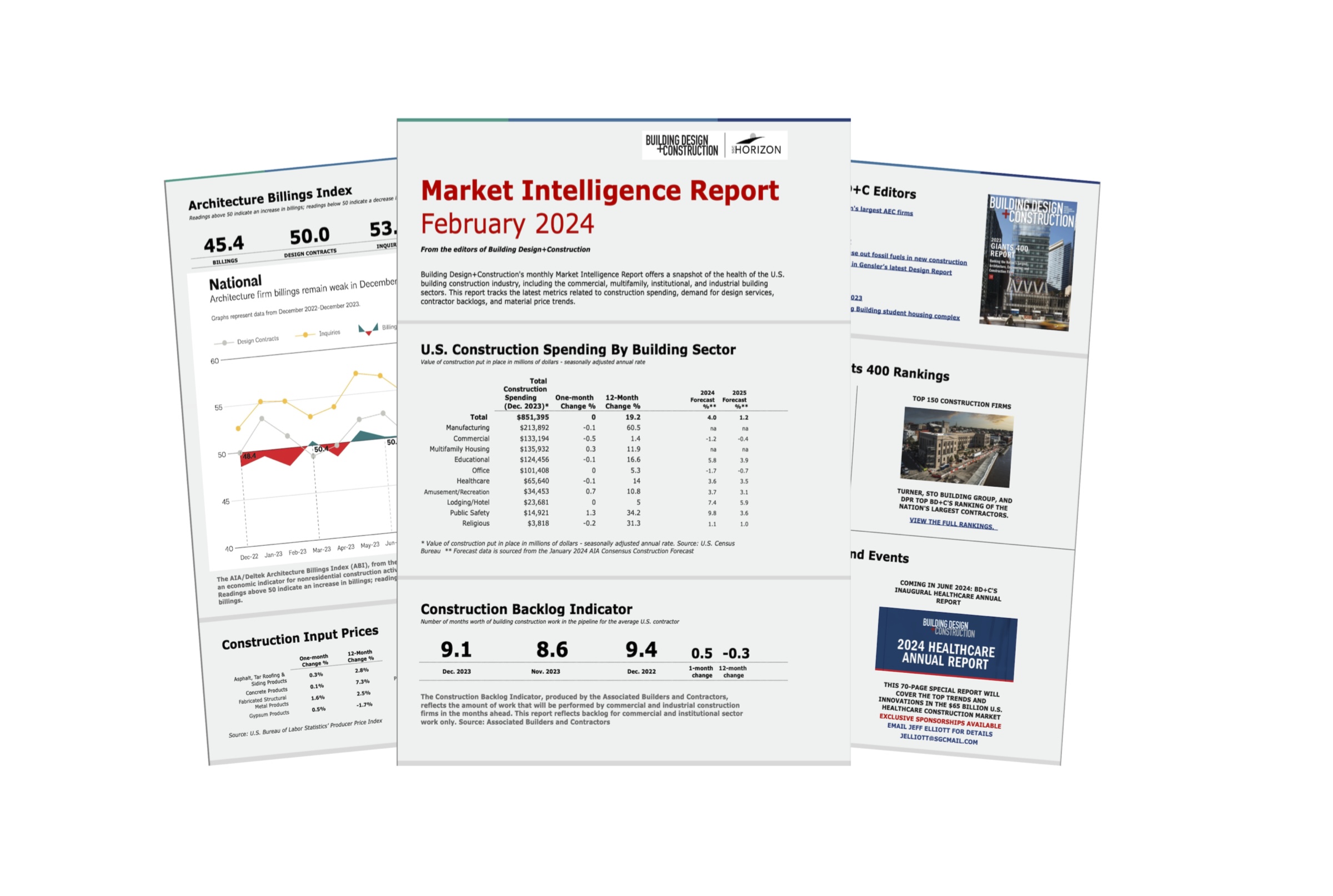Building Design+Construction's monthly Market Intelligence Report offers a snapshot of the health of the U.S. building construction industry, including the commercial, multifamily, institutional, and industrial building sectors. This report tracks the latest metrics related to construction spending, demand for design services, contractor backlogs, and material price trends.
Data for the Market Intelligence Report is gleaned from reputable economic sources, including the American Institute of Architects, Associated Builders and Contractors, and the U.S. Census Bureau.
Here are some of the highlights from the February 2024 report:
- Spending on vertical construction (i.e., "commercial buildings" work) is at a near all-time high, at $851.4 billion in annualized spending. However, inflation plays into this equation; building projects are more costly to plan, design, and build.
- Multifamily continues to shine, with 11.9% YOY growth to $135.9 billion in annual spending. Economists are calling for a slowdown, but not until 2025-26. Even at that, construction spending will hover at near all-time highs.
- Other hot sectors: manufacturing, education, healthcare, public safety, and religious.
- The 2024-25 forecast (from AIA) for key markets looks promising; only commercial/retail and office are expected to see a pullback in construction spending. Hotels, multifamily, education, and healthcare are all expected to see strong spending increases.
- The average U.S. contractor currently has 9.1 months worth of building construction work in the pipeline, which is slightly higher for the month and on par with the previous year.
- AIA's Architecture Billings Index has remained below 50 for the past six months, which means more firms than not are experiencing a decrease in billings.
- Construction material prices have largely stabilized. We're not seeing the volatile swings in prices and availability experienced during the pandemic.
Related Stories
Market Data | Feb 10, 2016
Nonresidential building starts and spending should see solid gains in 2016: Gilbane report
But finding skilled workers continues to be a problem and could inflate a project's costs.
Market Data | Feb 9, 2016
Cushman & Wakefield is bullish on U.S. economy and its property markets
Sees positive signs for construction and investment growth in warehouses, offices, and retail
Market Data | Feb 5, 2016
CMD/Oxford forecast: Nonresidential building growth will recover modestly in 2016
Increased government spending on infrastructure projects should help.
Market Data | Feb 4, 2016
Mortenson: Nonresidential construction costs expected to increase in six major metros
The Construction Cost Index, from Mortenson Construction, indicated rises between 3 and 4% on average.
Contractors | Feb 1, 2016
ABC: Tepid GDP growth a sign construction spending may sputter
Though the economy did not have a strong ending to 2015, the data does not suggest that nonresidential construction spending is set to decline.
Data Centers | Jan 28, 2016
Top 10 markets for data center construction
JLL’s latest outlook foresees a maturation in certain metros.
Market Data | Jan 20, 2016
Nonresidential building starts sag in 2015
CDM Research finds only a few positive signs among the leading sectors.
Market Data | Jan 20, 2016
Architecture Billings Index ends year on positive note
While volatility persists, architecture firms reported healthy performance for 2015.
Market Data | Jan 15, 2016
ABC: Construction material prices continue free fall in December
In December, construction material prices fell for the sixth consecutive month. Prices have declined 7.2% since peaking in August 2014.
Market Data | Jan 13, 2016
Morgan Stanley bucks gloom and doom, thinks U.S. economy has legs through 2020
Strong job growth and dwindling consumer debt give rise to hope.















